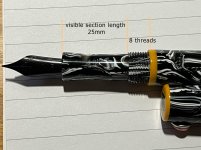jhiggi83
Member
I've been debating whether to invest $300 in an M13 triple-start tap and die set. Up until now, I've only used a single-start tap and die, but I'm curious how much customers actually value the triple-start feature when buying bespoke pens. Some advice I've gotten (including from ChatGPT) suggests that once you're charging more than $200 for a pen, a triple-start cap is almost expected.
What's been your experience — do customers really notice or care about this feature, or is it more of a "maker's detail" than a dealbreaker for buyers?
What's been your experience — do customers really notice or care about this feature, or is it more of a "maker's detail" than a dealbreaker for buyers?

